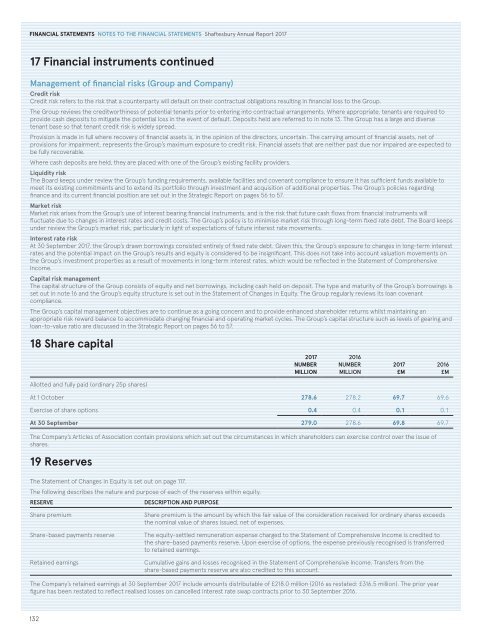Shaftesbury AR 2017 LR
You also want an ePaper? Increase the reach of your titles
YUMPU automatically turns print PDFs into web optimized ePapers that Google loves.
FINANCIAL STATEMENTS NOTES to the financial statements <strong>Shaftesbury</strong> Annual Report <strong>2017</strong><br />
17 Financial instruments continued<br />
Management of financial risks (Group and Company)<br />
Credit risk<br />
Credit risk refers to the risk that a counterparty will default on their contractual obligations resulting in financial loss to the Group.<br />
The Group reviews the creditworthiness of potential tenants prior to entering into contractual arrangements. Where appropriate, tenants are required to<br />
provide cash deposits to mitigate the potential loss in the event of default. Deposits held are referred to in note 13. The Group has a large and diverse<br />
tenant base so that tenant credit risk is widely spread.<br />
Provision is made in full where recovery of financial assets is, in the opinion of the directors, uncertain. The carrying amount of financial assets, net of<br />
provisions for impairment, represents the Group’s maximum exposure to credit risk. Financial assets that are neither past due nor impaired are expected to<br />
be fully recoverable.<br />
Where cash deposits are held, they are placed with one of the Group’s existing facility providers.<br />
Liquidity risk<br />
The Board keeps under review the Group’s funding requirements, available facilities and covenant compliance to ensure it has sufficient funds available to<br />
meet its existing commitments and to extend its portfolio through investment and acquisition of additional properties. The Group’s policies regarding<br />
finance and its current financial position are set out in the Strategic Report on pages 56 to 57.<br />
Market risk<br />
Market risk arises from the Group’s use of interest bearing financial instruments, and is the risk that future cash flows from financial instruments will<br />
fluctuate due to changes in interest rates and credit costs. The Group’s policy is to minimise market risk through long-term fixed rate debt. The Board keeps<br />
under review the Group’s market risk, particularly in light of expectations of future interest rate movements.<br />
Interest rate risk<br />
At 30 September <strong>2017</strong>, the Group’s drawn borrowings consisted entirely of fixed rate debt. Given this, the Group’s exposure to changes in long-term interest<br />
rates and the potential impact on the Group’s results and equity is considered to be insignificant. This does not take into account valuation movements on<br />
the Group’s investment properties as a result of movements in long-term interest rates, which would be reflected in the Statement of Comprehensive<br />
Income.<br />
Capital risk management<br />
The capital structure of the Group consists of equity and net borrowings, including cash held on deposit. The type and maturity of the Group’s borrowings is<br />
set out in note 16 and the Group’s equity structure is set out in the Statement of Changes in Equity. The Group regularly reviews its loan covenant<br />
compliance.<br />
The Group’s capital management objectives are to continue as a going concern and to provide enhanced shareholder returns whilst maintaining an<br />
appropriate risk reward balance to accommodate changing financial and operating market cycles. The Group’s capital structure such as levels of gearing and<br />
loan-to-value ratio are discussed in the Strategic Report on pages 56 to 57.<br />
18 Share capital<br />
Allotted and fully paid (ordinary 25p shares)<br />
<strong>2017</strong><br />
NUMBER<br />
MILLION<br />
2016<br />
NUMBER<br />
MILLION<br />
At 1 October 278.6 278.2 69.7 69.6<br />
Exercise of share options 0.4 0.4 0.1 0.1<br />
At 30 September 279.0 278.6 69.8 69.7<br />
The Company’s Articles of Association contain provisions which set out the circumstances in which shareholders can exercise control over the issue of<br />
shares.<br />
19 Reserves<br />
The Statement of Changes in Equity is set out on page 117.<br />
The following describes the nature and purpose of each of the reserves within equity.<br />
RESERVE<br />
DESCRIPTION AND PURPOSE<br />
<strong>2017</strong><br />
£M<br />
2016<br />
£M<br />
Share premium<br />
Share-based payments reserve<br />
Retained earnings<br />
Share premium is the amount by which the fair value of the consideration received for ordinary shares exceeds<br />
the nominal value of shares issued, net of expenses.<br />
The equity-settled remuneration expense charged to the Statement of Comprehensive Income is credited to<br />
the share-based payments reserve. Upon exercise of options, the expense previously recognised is transferred<br />
to retained earnings.<br />
Cumulative gains and losses recognised in the Statement of Comprehensive Income. Transfers from the<br />
share-based payments reserve are also credited to this account.<br />
The Company’s retained earnings at 30 September <strong>2017</strong> include amounts distributable of £218.0 million (2016 as restated: £316.5 million). The prior year<br />
figure has been restated to reflect realised losses on cancelled interest rate swap contracts prior to 30 September 2016.<br />
132



